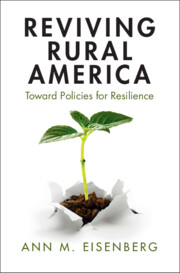Book contents
- Reviving Rural America
- Reviving Rural America
- Copyright page
- Contents
- Figures
- Acknowledgments
- 1 Introduction
- 2 The Foundational Myths
- 3 The Myth of Rural Empowerment
- 4 The Myth of Rural Unsustainability
- 5 The Myth of Rural Decline
- 6 The Myth of Rural Radicalism
- 7 The Myth of Rural Whiteness
- 8 The Myth of Rural Obsolescence
- Index
7 - The Myth of Rural Whiteness
Published online by Cambridge University Press: aN Invalid Date NaN
- Reviving Rural America
- Reviving Rural America
- Copyright page
- Contents
- Figures
- Acknowledgments
- 1 Introduction
- 2 The Foundational Myths
- 3 The Myth of Rural Empowerment
- 4 The Myth of Rural Unsustainability
- 5 The Myth of Rural Decline
- 6 The Myth of Rural Radicalism
- 7 The Myth of Rural Whiteness
- 8 The Myth of Rural Obsolescence
- Index
Summary
This chapter challenges the myth that rural communities lack racial diversity and that “rural” is synonymous with “white.” The chapter addresses in particular the misconception that, where rural regions do overrepresent white people, there is something natural or innate about the connection between rurality and whiteness. The chapter uses a critical-legal lens to examine the history and modern conditions associated with rural landownership and livelihoods. This analysis helps illustrate, in the words of Jess Shoemaker, “how rural landscapes got so white.” Certain experiences of the Gullah-Geechee people of South Carolina offer a case study for exploring heirs’ property, racial discrimination, and other mechanisms used to contribute to rural racial minorities’ land dispossession. The discussion demonstrates how property law, federal interventions, and other areas of law have facilitated the construction of rural regions as disproportionately white and racially stratified. Once again, the analysis reveals how rural America is a manmade project of public creation, rather than the product of benign or natural forces.
Keywords
- Type
- Chapter
- Information
- Reviving Rural AmericaToward Policies for Resilience, pp. 156 - 172Publisher: Cambridge University PressPrint publication year: 2024



